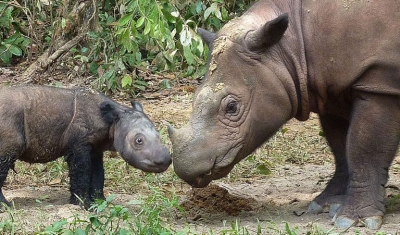
Extinct in Malaysia
The saddest news I heard last week: The Sumatran rhinoceros is now extinct in Malaysia.
Iman, the last female in Malaysia, at the Tabin Wildlife Reserve, in northeast Borneo, died in November 23, 2019. Another Sumatran rhino, Puntung was put to death in 2017. He had cancer. Tam, Malaysia’s last male rhino, died in May 2019. Fewer than 80 Sumatran rhinos are thought to exist in the wild, most on the nearby island of Sumatra. The rest are scattered across Kalimantan in Indonesia Borneo.
Christine Liew, Sabah State’s Minister of Tourism, Culture and Environment, said, “Iman was given the very best care and attention since her capture in March 2014 right up to the moment she passed. No one could have done more.” The saddest part is this. Once these rhinos roamed the jungles of Malaysia in large numbers. With habitat loss and killing of these animals for their horns, their numbers came down. Now, no Sumatran rhino is left in Malaysia.
Tam’s death is a wakeup call to find more animals in the wild, say experts coordinating WWF International’s Sumatran rhino efforts for the last two years.
This is Tam’s story. Forest officials noticed Tam wandering around an oil pam plantation in 2008. He was captured and transferred to the Tabin Wildlife Reserve in the state of Sabah. Efforts were made to mate him with two female rhinos – Puntung, captured in 2011, and Iman, captured in 2014. They were not successful.
Where do they live?
Sumatran rhinos live in remote areas of tropical rainforests. The Leuser Ecosystem, which abounds in mountains and tropical rainforest, in Indonesia is home to several small, scattered populations of Sumatran rhinos. Since these are thick jungles, sightings of rhinos are rare. No one can say exactly how many exist. Forest officials count the rhinos through what they see in camera traps.
In 2015, Sumatran rhinos were declared extinct in the wild in Malaysia. Naturalists count these reasons for the population count of rhino diminishing in Malaysia and elsewhere.
Sumatran rhinos live in small herds, scattered across islands. A small population means the Sumatran rhino’s potential to reproduce is reduced. This puts the rhino at a higher risk for extinction.
The number of Sumatran rhinos everywhere has dropped an estimated 70% in the past twenty years. This is mostly due to poaching. Fewer than a hundred remain in Indonesia, in isolated pockets. Besides, Sumatran rhinos give birth about every three to five years. So their population remains small.
Efforts to save the species
In 2018, the world’s leading conservation NGOs including the National Geographical Society, decided to form a collaboration group called the Sumatran Rhino Rescue. The members would go out, find and safely capture as many wild rhinos as possible and bring them together for captive breeding. Officials at the WWF International said, “Tam’s death underscores how critically important the collaborative efforts driving the Sumatran Rhino Rescue project are. We’ve got to capture those remaining, isolated rhinos in Kalimantan and Sumatran and do our best to encourage them to make babies.”
The experts, however, were able to understand the kind of animal Sumatran rhinos are by monitoring Tam in captivity. This information should help biologists in their rhino breeding efforts in the future. “The work that the Borneo Rhino Alliance did with advanced reproductive techniques, especially harvesting eggs and attempting to create embryos, took us one step further towards understanding of the species’ biology,” said Susie Ellis, executive director of the International Rhino Foundation.
What can we do?
We must understand how precarious the survival of Sumatran rhinos is. Don’t we want this small rhinoceros to survive? The death of Tam represents roughly one percent of the Sumatran rhino population.
But there is good news. The coalition group, Sumatran Rhino Rescue has managed to capture a new female named Pahu. She has been transferred to a new breeding facility in Kelian, Indonesia. This effort was seen as extremely important and the rhino was given escort by the Indonesian police who helped to clear the mudslides on the way with bulldozers. As far as experts can tell, Pahu does seem to be reproductively healthy. She is doing well in her new home, and we can all keep our fingers crosses for her to have company soon. Pahu’s capture shows that there are other rhinos still roaming in Kalimantan’s forests and that in turn gives hope for the animal species future. Experts say that the world needs to be laser-focused on saving the remaining 80 Sumatran rhinos, using a combination of intensive protection and captive breeding, and working with local people to instill pride that the rhino is part of their biological heritage. “This is a battle we cannot afford to lose.”
Picture Credit : Google

